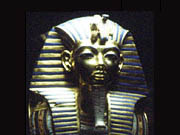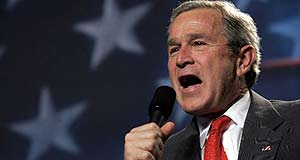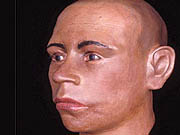RENCONTRER
DIEU |
COURRI@L
2005
|
MEET
WITH GOD |
 |
G.W. Bush and the 3 Martians
(2005-Jan-18)
Angaro2: Mr President! On November 2, 2004, Charlie Jones
asked "Are U.S. Marines returning to Cambodia?"
Angaro1: Today, Bill Gertz says China will go militarily
from Pakistan to Burma to Cambodia.
Angaro3: So, what will you say?
G.W. Bush: All right! Good news, folks! Just listen to my
speech on Thursday, January 20!
|
|
China builds up strategic sea lanes
Carre Caress : .... through Cambodia!
[By Bill Gertz in THE WASHINGTON TIMES] : China is building
up military forces and setting up bases along sea lanes from the Middle
East to project its power overseas and protect its oil shipments, according
to a previously undisclosed internal report prepared for Defense Secretary
Donald H. Rumsfeld. "China is building
strategic relationships along the sea lanes from the Middle East to the
South China Sea in ways that suggest defensive and offensive positioning
to protect China's energy interests, but also to serve broad security objectives,"
said the report sponsored by the director, Net Assessment, who heads Mr.
Rumsfeld's office on future-oriented strategies. The Washington Times obtained
a copy of the report, titled "Energy Futures in Asia," which was produced
by defense contractor Booz Allen Hamilton. The internal report stated that
China is adopting a "string of pearls" strategy of bases and diplomatic
ties stretching from the Middle East to southern China that includes a
new naval base under construction at the Pakistani port of Gwadar.
Beijing already has set up electronic eavesdropping posts at Gwadar in
the country's southwest corner, the part nearest the Persian Gulf. The
post is monitoring ship traffic through the Strait of Hormuz and the Arabian
Sea, the report said.
Other "pearls" in the sea-lane strategy include:
• Bangladesh: China is strengthening its ties to the government and building
a container port facility at Chittagong. The Chinese are "seeking much
more extensive naval and commercial access" in Bangladesh.
• Burma: China has developed close ties to the military regime in Rangoon
and turned a nation wary of China into a "satellite" of Beijing close to
the Strait of Malacca, through which 80 percent of China's imported oil
passes. China is building naval bases in Burma
and has electronic intelligence gathering facilities on islands
in the Bay of Bengal and near the Strait of Malacca. Beijing also supplied
Burma with "billions of dollars in military assistance to support a de
facto military alliance," the report said.
•Cambodia: China signed a military
agreement in November 2003 to provide training and equipment. Cambodia
is helping Beijing build a railway line from southern
China to the sea.
•South China Sea: Chinese activities in the region are less about territorial
claims than "protecting or denying the transit of tankers through the South
China Sea," the report said. China also is building up its military forces
in the region to be able to "project air and sea power" from the mainland
and Hainan Island. China recently upgraded a military airstrip on Woody
Island and increased its presence through oil drilling platforms and ocean
survey ships.
•Thailand: China is considering funding construction of a $20 billion canal
across the Kra Isthmus that would allow ships to bypass the Strait
of Malacca. The canal project would give China port facilities, warehouses
and other infrastructure in Thailand aimed at enhancing Chinese influence
in the region, the report said.
The report reflects growing fears in the Pentagon about China's long-term
development. Many Pentagon analysts believe China's military buildup is
taking place faster than earlier estimates, and that China will use its
power to project force and undermine U.S. and
regional security. The U.S. military's Southern Command
produced a similar classified report in the late 1990s that warned that
China was seeking to use commercial port facilities around the world to
control strategic "chokepoints." A Chinese company with close ties to Beijing's
communist rulers holds long-term leases on port facilities at either end
of the Panama Canal. The Pentagon report said China,
by militarily controlling oil shipping sea lanes, could threaten ships,
"thereby creating a climate of uncertainty about the safety of all ships
on the high seas." The report noted that the vast amount of oil
shipments through the sea lanes, along with growing piracy and maritime
terrorism, prompted China, as well as India, to build up naval power at
"chokepoints" along the sea routes from the Persian Gulf to the South China
Sea.
"China ... is looking not only to build a blue-water navy to control the
sea lanes, but also to develop undersea mines and missile capabilities
to deter the potential disruption of its energy supplies from potential
threats, including the U.S. Navy, especially in the
case of a conflict with Taiwan," the report said. Chinese weapons
for sea-lane control include new warships equipped with long-range cruise
missiles, submarines and undersea mines, the report said. China also is
buying aircraft and long-range target acquisition systems, including optical
satellites and maritime unmanned aerial vehicles. The focus on the naval
buildup is a departure from China's past focus on ground forces, the report
said.
"The Iraq war, in particular, revived concerns over the impact of a disturbance
in Middle Eastern supplies or a U.S. naval blockade," the report said,
noting that Chinese military leaders want an ocean-going navy and "undersea
retaliatory capability to protect the sea lanes." China believes the
U.S. military will disrupt China's energy imports in any conflict over
Taiwan, and sees the United States as an unpredictable country that violates
others' sovereignty and wants to "encircle" China,
the report said. Beijing's leaders see access to oil and gas resources
as vital to economic growth and fear that stalled economic growth could
cause instability and ultimately the collapse of their nation of 1.3 billion
people.
Energy demand, particularly for oil,
will increase sharply in the next 20 years — from 75 million barrels per
day last year to 120 million barrels in 2025 — with Asia consuming 80 percent
of the added 45 million barrels, the report said. Eighty percent of China's
oil currently passes through the Strait of Malacca, and the report states
that China believes the sea area is "controlled by the U.S. Navy." Chinese
President Hu Jintao recently stated
that China faces a "Malacca Dilemma" — the vulnerability of its oil supply
lines from the Middle East and Africa to disruption. Oil-tanker traffic
through the Strait, which is closest to Indonesia, is projected to grow
from 10 million barrels a day in 2002 to 20 million barrels a day in 2020,
the report said. Chinese specialists interviewed for the report said the
United States has the military capability to cut off Chinese oil imports
and could "severely cripple" China by blocking its energy supplies.
Click here for Are U.S. Marines returning to Cambodia? by
Charlie Jones
Mrs Hun Sen is the major shareholder of a prominent gasoline company
(2005-Jan-12)
K.I. : Prime Minister Hun Sen's wife
Bun Rany (real name: Bun Sam Heang) is officially the major shareholder
of Kampuchea Tela, which is Cambodia's
main gasoline distribution company along with CPP-affiliated conglomerate
Sokimex. The two companies, which control
more than 80 percent of the local market, are engaged in a massive
gasoline smuggling that deprives the State of tax revenues amounting to
approximately $90 million a year.
Hun Sen may form new party with Ranariddh (2005-Jan-12)
K.I. : CPP Vice-President Hun Sen may
break away from his party and form a new political party with Funcinpec
President Norodom Ranariddh. The two politicians have clearly different
motives.
- Ranariddh realizes that his "royalist" party, which has continuously
lost ground over the last ten years, cannot stand alone and may be virtually
eliminated from the political scene at the next general elections in 2008
without a strong and intimate support from the CPP or at least the pro-Hun
Sen faction of the CPP.
- Hun Sen knows that the majority of the 20-member Standing Committee
(former Politburo) and probably also a majority in the 153-member Central
Committee of the CPP will not support him to be
the party's candidate for prime minister for a fourth 5-year
term in 2008. Besides threatening his opponents within the CPP, he is considering
alternatives that would imply a new deal in Cambodian politics.
Toutankhamon, sans chair et en os (2005-Jan-09)
|
Radio-Canada.Ca : Des chercheurs égyptiens commandités
par le National Geographic ont passé la momie du pharaon
Toutankhamon au scanner. Les images montrent que le crâne est intact
(?), mais que le reste du corps est en mauvais
état. Les 1700 photos prises mardi au cours de cette radiographie,
qui n'a duré qu'une quinzaine de minutes, pourraient permettre d'en
savoir plus sur la vie et la mort de ce jeune monarque ainsi que sur sa
généalogie. C'est la quatrième fois que son sarcophage
est ouvert. En 1925, trois ans après sa découverte, puis
en 1969 et en 1986 pour des examens aux rayons X. Et puis en 2005, pour
un examen au scanner. |
|
 |
Un peu d'histoire
Toutankhamon n'avait que huit
ans lorsqu'il est monté sur le trône d'Égypte.
Il a régné de 1333 à 1323 avant Jésus-Christ,
année de son décès. La tombe du pharaon, mort à
17 ans, fut mise au jour dans la vallée des Rois en 1922 par l'archéologue
anglais Howard Carter. Le corps du pharaon était enseveli dans trois
cercueils gigognes, dont un en or massif, la tête recouverte d'un
masque d'or. En 1968, une radiographie a permis de détecter des
fragments osseux à l'intérieur du crâne, ce qui suggère
que le jeune pharaon a pu être tué d'un coup à la tête.
|
|
Mais le mystère n'est pas totalement
levé. En 2002, des chercheurs de Nouvelle-Zélande avaient
fait appel à des techniques numériques utilisées par
la police pour reconstituer les traits du visage de Toutankhamon.
Sirik Matak en voulait à Sihanouk (2005-Jan-03)
Pen Nearovi : Dommage que Sisowath Sirik Matak
et Lon Nol mouraient sans laisser de mémoires sur le 18-Mars-1970.
Notons que, avant le prince Sihanouk, le général Lon Nol
venait se faire soigner en France et laissait l'intérim au prince
Sirik Matak. Après le "coup d'État", beaucoup d'étudiants
et de fonctionnaires venaient à Paris pour continuer des études
ou effectuer des stages. Certains d'entre eux disaient que Sirik
Matak, qui avait placé certaines unités de l'armée
sous son commandement direct, poussait
Lon Nol à renverser Sihanouk. Ceci était assez vraisemblable
car, d'un côté on savait que les princes khmers voulaient
tous monter sur le trône (le roi Sihanouk lui-même a récemment
décrit les attitudes de Sisowath Youttévong et de Norodom
Norindeth), et de l'autre on connaissait le niveau politique de Lon Nol,
un fonctionnaire civil habitué à s'agenouiller devant Sihanouk
et prendre les ordres de ce dernier : sans la complicité d'un membre
haut placé de la famille royale, jamais Lon Nol n'oserait se rebeller
contre son auguste "Samdech Ov".
C'était vrai aussi que le comportement des Nord-Vietnamiens et des
Vietcongs mécontentait beaucoup l'armée khmère. Alors,
des témoignages des ex-militaires haut gradés sur le rôle
de Sisowath Sirik Matak aideraient à faire la lumière sur
les événements de mars-avril 1970 et seraient les bienvenus.
Sirik Matak avait un double grief contre Sihanouk. Primo, les Sisowath
ont perdu la couronne (à cause certes de Pétain et de Decoux)
au profit des Norodom. Secundo, ce qui est moins connu du public, le roi
Sihanouk a volé du prince Sirik Matak, personnellement, nul autre
que ... Monique Izzi. |
|
En effet, lors d'une visite familiale à son cousin, Sa Majesté
a vu la très belle domestique (?) Monique placée par madame
Pomme Peang chez Sirik Matak. Le roi demanda alors au prince de la lui
donner, et ... on ne dit pas "non" à un monarque.
On connaît la suite. Sihanouk jouait la "Haute Politique" et cachait
des Vietcongs, le clan Monique-Pomme Peang-Oum Manorine y était
impliqué et gagnait en argent et en pouvoir, Sisowath Sirik Matak
voyait ... rouge! Il aurait pu dire à Lon Nol : "Le bataillon de
Phnom Penh est sous mes ordres, je vais inciter la population à
manifester contre les ambassades vietcong et nord-vietnamienne puis renverser
le prince chef d'État, ou vous marchez avec moi ou vous serez contre
moi"!
Autre remarque : En 1952, Monique avait 16
ans. Alors, Norodom Sihanouk était-il
pédophile
?
Rithourn OM : J'estime que j'étais assez bien placé,
en tant que jeune ingénieur formé au Cambodge et Président
des Étudiants de l'Université de Kampong Cham, pour analyser
avec un certain recul ce qui s'est passé en 1970. Comprenons que
le terme de "COUP D'ETAT" n'a aucun
sens en ce temps. Du temps où on était, il y avait San That,
Président des Étudiants de la Fac de Droit, Men Hoeun, Président
des Étudiants de l'université de Techno Russe et Porte-Parole
des Présidents des Étudiants des Universités (hélas
assassiné sous le régime des KR) et moi-même Président
des Étudiants de l'Université de Kampong Cham (Keat Chhon
était Recteur et Professeur de thermodynamique) avec trois autres
Présidents des fac (Takeo-Kampot, Commerce, et Beaux-Arts) dont
les noms m'ont complétement échappé après 30
ans de séparation, nous tous avons signé au nom de l'Assemblée
des Présidents des Étudiants des Universités pour
la destitution de Samdech Norodom Sihanouk
et opté pour le choix d'une République.
Nos signatures ont certes appuyé la destitution de Samdech Norodom
Sihanouk par les parlementaires, et étaient exploitées peut-être
par les parlementaires. Mais réellement nous l'avons fait pour contester
une certaine injustice sociale qui a été perçue
par les étudiants dont 90% venaient de la masse paysanne. Et ne
parlons pas des fils et filles de notables qui n'avaient même pas
de baccalauréat mais qui passaient deux, trois, voire quatre ans
en France pour frimer et rentrer après au Cambodge pour diriger
ces jeunes ingénieurs venant "d'en bas".
Le régime princier de Samdech Norodom Sihanouk gérait le
pays sans coup férir et en toute quiétude parce que les trois
pouvoirs (exécutif, législatif et judiciaire), soi-disant
indépendants, ont été en fait tenus par la haute sphère
du Palais Royal. A partir de là, nul n'est dupe même si certains
essayent de se redorer le blason et glorifier telle ou telle époque
pour justifier un certain régime autoritariste
qui n'avait rien à envier aux régimes de Pékin ou
de Ceaucescu. Et Dieu sait qu'à cette époque (1970), la masse
intellectuelle à 80% a soutenu le changement de régime, non
point pour dédaigner la monarchie mais ne serait-ce que pour mettre
dehors les clans et les cliques qui accaparaient tous les patrimoines nationaux
et en faisaient leurs propriétés privées.
Mais soit ! Que maintenant, ici et là, chacun se plaise à
dire qu'effectivement "IL S'AGISSAIT D'UN COUP D'ETAT", j'aimerais quand
même que les juristes cambodgiens imprégnés de foi
de profession définissent en toute impartialité ce qu'est
un "COUP D'ETAT". Impatiemment, juristes,
j'attends vos définitions, notamment de Bang Docteur en droit et
Professeur Douc Rasy dont je me ferai un réel plaisir de lire la
réponse.
[cf. Le naufrage princier et le renouveau escompté]
Virak Pruhm : LLoyd Shearer met Samdech Sihanouk and Princess Monique
in Peking in July 1973. On his July 73's report he stated that Prince Sihanouk
met Princess Monique in 1951 while she was 15, and took her into his [Sihanouk's]
household and married her in 1955. If king Sihamoni
was born in May 1953, then he was conceived some time in August
1952. At that time Princess Monique was 16. So Prince Sihanouk and Princess
Monique were probably having fun in August of 1952, three years before
they got married in 1955.
Shearer
stated that, "Oddly enough, Princess Monique Sihanouk has no Cambodian
blood. She was born in Saigon on June 18, 1936. Her mother, Madame Pomme,
is a Vietnamese, and her father, a Franco-Italian named Izzi, was killed
in World War II. The question is who was Madame Pomme? If she was a Vietnamese
then, Monique is a mixed and has no Khmer blood in her at all.
With
a man of that Status (Sihanouk), someone had to know when and where he
got married. How come there is no record about that? What about babies
who were born before their parents' marriage? Are they qualified to become
King or Queen? Interesting!
[cf. Monique too greedy, in Angkor Borei News]
GOD
vs BUDDHA
|
camboDIATRIBE
|
COURRI@L
2005
( PREVIOUS )
|
AUTRES
SITES KHMERS
|
KUN
PIMOJ 's HOMEPAGE
|
PHN@M-P@NH-P@TINS
|
FRAN-GLO-GIBWÉ
|
CANADA
3 FOUNDERS
|
MES
EMAILS 2003
|
THE
6 COMMANDMENTS
|
MEET
WITH GOD
|
PEN Nearovi, Montréal, Québec, Canada
(nearovi@sympatico.ca)





